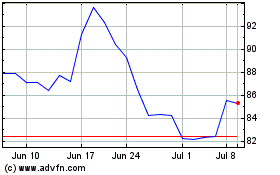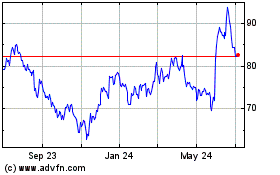Cash-strapped SolarCity Corp. is trying to cut marketing costs
amid competition from smaller upstarts using cheaper sales
tactics—such as paying Uber drivers to pitch solar panels to
passengers.
Big solar companies such as SolarCity and Vivint Solar Inc. have
been engaged in a fierce battle to amass market share, analysts
say, and have spent heavily on old-fashioned advertising, telephone
and door-to-door canvassing, and booths at retail outlets to
acquire new customers. But the companies are spending more than
they are taking in, and the costs are proving hard to sustain.
SolarCity spent $751 million in 2015 on sales, administrative
and research costs, 88% more than its annual revenue of $400
million and the $399 million it spent the previous year. Through
June, it had spent $438 million this year, 42% more than its
revenue of $308 million. Its cash declined to $146 million on June
30 from $421 million a year earlier.
Seeking to survive as a stand-alone company until its proposed
merger with Tesla Motors Inc., SolarCity has begun selling more
solar panels to homeowners for cash, rather than its traditional
business of leasing the panels and retaining ownership. It is also
planning to sell outside investors more shares than it owns.
Earlier this month, SolarCity raised $305 million through once
such cash equity transaction with Quantum Strategic Partners Ltd.,
the hedge fund of billionaire investor George Soros. Last month, it
sold $100 million of bonds to its chairman, Elon Musk, who is also
Tesla's chief executive, and SolarCity's two top executives.
Cutting costs is also a crucial part of its plan. SolarCity has
stopped buying television ads but is still advertising on the
internet, selling door to door and setting up booths at Home Depot
Inc. and Best Buy Co. stores. Its sales and marketing costs should
drop further after its planned merger with Tesla Motors, when the
combined company would sell panels at Tesla's auto showrooms, said
Chief Executive Lyndon Rive.
"We had a lot of headwinds that hit us" this year, Mr. Rive
said, noting that Nevada regulators last December terminated
lucrative state incentives for rooftop solar, dealing a major blow
to home solar companies.
Another challenge: Competition from smaller solar installers,
who are using lower-cost methods to reach people. Online
marketplaces such as Project Sunroof, a unit of Alphabet Inc.'s
Google, connect homeowners with installers and other online
networks, such as Pick My Solar and PowerScout, which solicit bids
from local installers to help consumers get the best local
deal.
Regional and smaller firms supplied about 48% of the home solar
market earlier this year, up from 47% at the end of 2015, according
to GTM Research.
One such online network, Geosteller, is testing an unusual sales
tactic: using Uber and Lyft drivers to sell panels to riders.
The privately held company has enlisted about 50 drivers in New
York, Boston, San Francisco, Los Angeles, Washington, Dallas and
Miami, who can snag commissions that start at about $1,000 per sale
of solar systems. Home solar systems average about $18,840 per
six-kilowatt array, according to GTM.
Geosteller Chief Executive David Levine said the method is
showing promise: drivers have generated about 220 sales since
June.
"I don't feel like I'm selling something. I'm giving them
information and showing them the savings potential with solar,"
said Quin Yowell, 51, who drives part-time for Uber and Lyft to
supplement his income at Whole Foods in the Washington, D.C.,
area.
Mr. Yowell, who has sold three systems so far, said he doesn't
bother passengers who are talking or texting on mobile phones, or
otherwise seem occupied.
Uber and Lyft declined to comment.
Big marketing spending is unusual for a consumer technology that
most customers buy after hearing about from a friend, neighbor or
family member, said Hugh Bromley, an analyst at research firm
Bloomberg New Energy Finance.
Home solar companies with a high-cost business model could face
a "death spiral" of rising costs and lower sales as growth slows,
he added.
Bloomberg New Energy Finance is predicting 0.3% growth in the
home solar market in 2017, due to a nationwide drop in conventional
power prices and reductions in state solar incentives.
GTM Research and the Solar Energy Industries Association predict
19% growth next year, down from an expected 23% increase in
residential installations this year and a 66% jump in 2015.
"We're not yet hitting the point where growth stops entirely,
but the curve is undeniably slowing down," said Shayle Kann, senior
vice president at GTM.
SolarCity has lowered its forecast for the volume of panels it
plans to install this year to 900 to 1,000 megawatts, down from
1,250 megawatts earlier this year.
Write to Cassandra Sweet at cassandra.sweet@wsj.com
(END) Dow Jones Newswires
September 22, 2016 13:15 ET (17:15 GMT)
Copyright (c) 2016 Dow Jones & Company, Inc.
Best Buy (NYSE:BBY)
Historical Stock Chart
From Mar 2024 to Apr 2024

Best Buy (NYSE:BBY)
Historical Stock Chart
From Apr 2023 to Apr 2024
